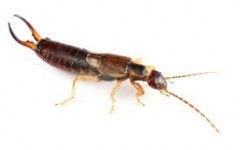About Earwigs
 Although earwigs look frightful in appearance and move rapidly, they pose no threat to humans. Typically they come inside as the weather cools down to hide from the cold. If not inside during the cooler months, the earwig will burrow 2 to 3 inches into the ground. During the late winter to early spring months, the earwig females will lay around 25 eggs The name for the pests came from an old wives’ tale that told how the insects like to crawl into human’s ears at night when they are sleeping and lay their eggs. This has been proven to be untrue. If threatened the earwig might try to defend itself by pinching with it’s “claws.” These pinches are essentially harmless and will typically not break the skin. Earwigs are most active during the nighttime and hide during the day. They mostly feed on living plants, which makes them a big nuisance around greenhouses and crops. If in the home, you will most likely spot them around the home’s foundation, faucets, and air-conditioning units.
Although earwigs look frightful in appearance and move rapidly, they pose no threat to humans. Typically they come inside as the weather cools down to hide from the cold. If not inside during the cooler months, the earwig will burrow 2 to 3 inches into the ground. During the late winter to early spring months, the earwig females will lay around 25 eggs The name for the pests came from an old wives’ tale that told how the insects like to crawl into human’s ears at night when they are sleeping and lay their eggs. This has been proven to be untrue. If threatened the earwig might try to defend itself by pinching with it’s “claws.” These pinches are essentially harmless and will typically not break the skin. Earwigs are most active during the nighttime and hide during the day. They mostly feed on living plants, which makes them a big nuisance around greenhouses and crops. If in the home, you will most likely spot them around the home’s foundation, faucets, and air-conditioning units.
Earwig Prevention
In garden areas, the earwig can actually be a benefit to have around. They will assist in controlling unwanted pests such as aphids and mites. Inside the home they are typically unwanted visitors. There are some preventive measures that home owners can take to reduce the chances of earwigs entering the home. Most of these preventive measures are done outside of the home, which includes:
- Seal all cracks and crevices around the home where the pests have opportunities to enter.
- Don’t leave opened food out. Store in air-tight sealed containers if possible.
- Clean areas around the exterior foundation of the home. The build up of debris provides excellent hiding grounds for the earwigs.
- Reduce lighting around entrances such as doors, windows, and other entry points.
If all preventive measures fail then call a professional to assist with the intruders.

